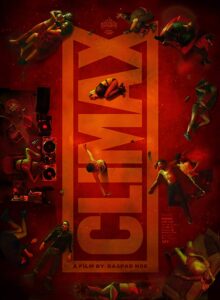New quasi-horror film is only for the strong of stomach.


Oh the horror genre in all its many interesting incarnations. Often the best entries find the terror in what exists authentically around us. Edgy filmmaker Gasper Noé seems to see something horrible in just about any situation. His new film, “Climax,” is a nasty display of psychedelic body horror that adds up to very little.
Following a series of dance company entrance interviews framed on an old television set, we get a marvelous dance sequence. The interviews composited onto a retro TV have been cleverly made to look like they were shot on VHS, surrounding the frame, we see various movie boxes. And it’s no accident that one of those films is Dario Argento’s 1977 dance infused horror classic “Suspiria.” Remade last year into an artsy-fartsy horror picture with an A-list cast, “Suspiria” is about a coven of witches that run a ballet school. Noé uses similar set-up as a jumping off point for his more grounded frightener.

The extended dance sequence that follows is where “Climax” begins to take flight. Shot in what appears to be an extended oner, the camera weaves into and then floats rhythmically above the dancers, who move in all sorts of inventive and impossible ways. This sequence almost saves the entire film, but when the narrative falls into a lurid and unpleasant drug induced nightmare, “Climax” falls apart. It’s all a terrible waste of young talent.
And to be fair, the cast, led by Sofia Boutella, is an attractive and dedicated group. After the entertaining dance routine, the film splits off into a flat series of two shots, where the participants pair up and chat. The banal conversations range from mildly amusing to downright pointless. But as the typical nonsensical party chatter winds down, the drugs kick in.

The odyssey into the depths of chaotic hell thereafter is a frustrating journey. And the trip is made even more exasperating by Noé’s camera choices. By working with his frequent collaborator, cinematographer Benoît Debie (“Spring Breakers”), we get harsh and ugly colors and awkward angles. The low light capabilities of the famed Arri Alexa Mini is pushed to the limit as lighting appears to be scantily employed especially as the nightmare gets completely off-the-rails.
There’s one ugly lengthy sequence where the camera takes us inside the personal space of the partiers, who are experiencing a pharmaceutically created psychotic break. I had to look away, not because of all the vomit and bloodletting, which was bad enough, but because the camera movement and intense, noisy, close-up images are nearly impossible to discern. The goal, obviously, is to make us experience something of the bad trip, but we’ve seen this kind of thing before superiorly handled in much better films. See the work of László Kovács in Dennis Hopper’s 1969 classic “Easy Rider.”

But aside from misplaced visual indulgence, Noé’s script disappears, rudderless, into the madness. Other than possibly some kind of “say no to drugs” cautionary play, viewers might ask, “what’s the point?” “Climax” is the Argentine filmmaker working in just one dimension. Where there should be layers, Noé presents us with too much of a single surface. “Climax” starts off with pretty people, whose bodies contort artfully, and it is ends with inartful flourish that’s supposed to resonate. It doesn’t.
